Cold-resistant type of onion “Slizun”
For a long time, only a small part of gardeners grew slime onions, but recently its popularity has grown. The increase in the number of fans of the culture is associated with its unpretentiousness, rich chemical composition and pleasant taste without bitterness. Even novice gardeners can cope with cultivating slime onions. To do this, it is enough to familiarize yourself with the nuances and rules of its cultivation.
Description of culture
Slime onion is a perennial representative of the Liliaceae family.. Once planted, it produces an early harvest every spring for 4-5 years. The crop is considered an excellent honey plant - its aroma attracts worker bees and drives away pests. That is why experienced gardeners prefer to place this type of onion in beds with other plants.
Reference. The plant received the name “slime” due to the high content of special mucous substances. They are used to treat stomach ulcers and gastritis with high acidity.
The most popular and healthy varieties of slime onions are considered:
- Leader;
- Green;
- Charm;
- Dwarf.
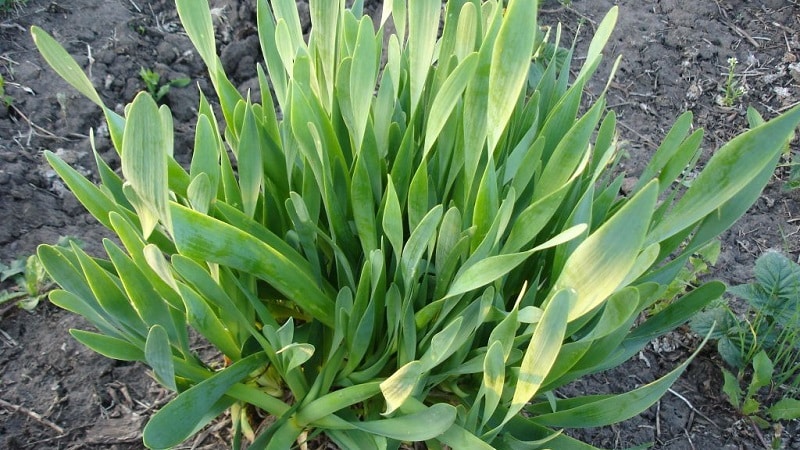
Origin and development
In the natural environment, wild varieties of slime are found in Altai, Siberia and Central Asia. At some point, people noticed that livestock enjoyed the plant and tried to eat it. Over time, succulent sprouts began to be grown in vegetable gardens, which led to the cultivation of slime.
Chemical composition
Slime onion has a rich chemical composition. It contains the following beneficial substances:
- vitamin C - 18.8 mg;
- manganese - 0.16 mg;
- zinc - 0.39 mg;
- iron - 1.48 mg;
- potassium - 276 mg;
- carotene - 0.598 mg;
- vitamin B9 - 64 mcg;
- pantothenic acid - 0.075 mg;
- choline - 5.7 mg;
- vitamin PP - 0.525 mg.
All of them are perfectly absorbed by the body, and with regular use Slime onions have a healing effect.
Reference. The greens of this onion have a low calorie content - only 32 kcal per 100 g of product.
Benefits and harms
Greens are recommended to be included in the diet when:
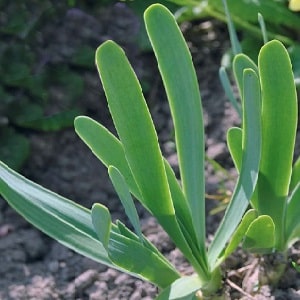 anemia - increases hemoglobin;
anemia - increases hemoglobin;- infectious diseases - improves immunity, relieves inflammation;
- poor appetite - improves the functioning of the gastrointestinal tract and normalizes the acid-base balance;
- fragility of blood vessels - improves the condition of the cardiovascular system, normalizes blood pressure;
- metabolic disorders - stabilizes the functioning of the thyroid gland and hormone levels.
Harm to health:
- risk of allergies and individual intolerances;
- the appearance of heartburn;
- dry skin when applied externally;
- exacerbation of chronic diseases of the gastrointestinal tract and urinary system.
Ripening period
The first shoots appear 20-35 days after sowing, this is influenced by air temperature and soil moisture. In the second year, the greens hatch immediately after the snow melts, and the first crop is ready for cutting in late April - early May.
Interesting things on the site:
Perennial onion with a pleasant smell “Dzhusai”
Productivity
Slime actively increases green mass throughout the growing season. Every year the number of shoots increases; in the second year of life, the plant acquires 3-4 branches with 8-10 leaves.By the fifth year, their number reaches 20-25, and up to 200 leaves are formed on one bush.
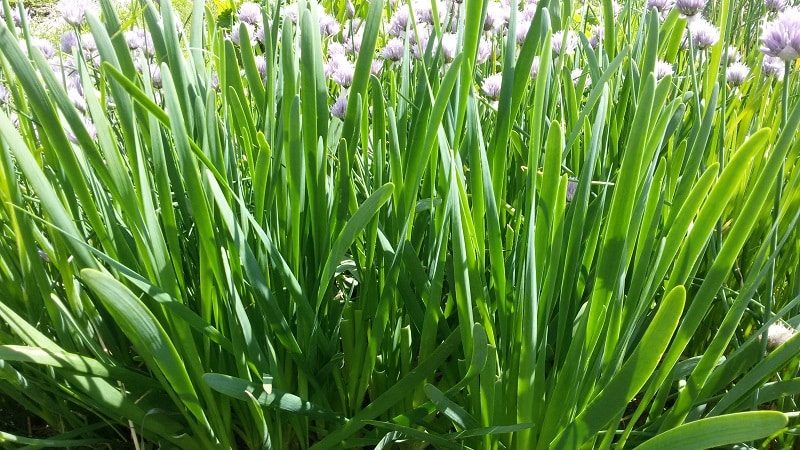
Slime onion is a very productive plant. The Green variety stands out especially. With good care, it produces up to 6 kg of greenery per 1 m² per cut.
Important! Do not grow slime for more than 5 years, as by this time the plant “gets tired” and reduces shoot formation.
Disease resistance
From wild ancestors, cultivated varieties of onions were obtained unpretentiousness, ability to repel pests and high immunity to various diseases. Breeders have endowed onions with additional resistance to fungal and viral infections while working on new varieties.
Characteristics of the bulb, description of appearance, taste
The slime onion has dark green leaves covered with a light waxy coating.. They have a pungent taste, and when broken, they release a slimy juice. The second name of this variety is drooping onion. The plant got it because of its arrows: young ones have a twisted appearance and bend towards the ground. As they grow, the arrows gradually straighten, stretch up to 100 cm, and lilac-lilac inflorescences form on their tops.
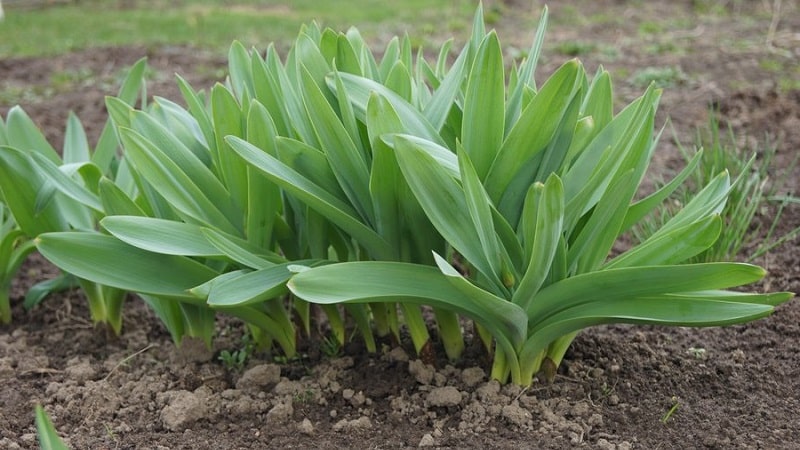
The slime has a developed root system, but it does not have a real bulb. Small cylindrical false bulbs grow from the rhizome with a diameter of 1.5-2 cm. By the end of the growing season, they grow around the central root and form a solid “onion” with a diameter of up to 25-30 cm. Some gardeners use such root crops for food, but slime onions are most often grown only for greens.
Young leaves are added to marinades, salads and eaten as a snack with main dishes.. They have a delicate, slightly sweet taste with a slight bitterness, garlic aroma and are completely devoid of pungency.
Growing regions
Slizun is winter-hardy and not afraid of cold weather, which is why it is grown in all regions of Russia. The culture takes root well and grows in Siberia, where it can withstand temperatures down to -40°C, even if the ground is not covered with snow.
Attention! The slime onion is moisture-loving, but dies during frequent winter thaws.
Advantages and disadvantages of the variety
Slime has a number of advantages. These include:
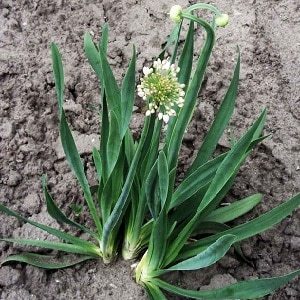 high productivity;
high productivity;- early appearance of greenery;
- unique chemical composition;
- pleasant taste and aroma;
- unpretentiousness;
- frost resistance;
- the ability to grow the crop for 4-5 years after planting.
But like any garden plant, this this variety has a number of disadvantages:
- poor reaction to flooding of the bed during thaws and heavy rains;
- small onions;
- intolerance to long droughts.
Difference from other varieties
Among the features of the slime:
- lack of rest period;
- greens remain juicy for a long time and quickly fade after frost;
- the harvest is harvested before autumn, since the foliage does not become coarse and does not become bitter;
- can be stored for a long time when cut.
Unlike other types of onions, slime contains a small amount of essential oils, so it’s not bitter at all.
Features of planting and growing
Slime onion is an unpretentious plant; it does not require complex care or special growing conditions.. However, to obtain a high-quality and abundant harvest, it is important to know the rules of planting and cultivating this crop.
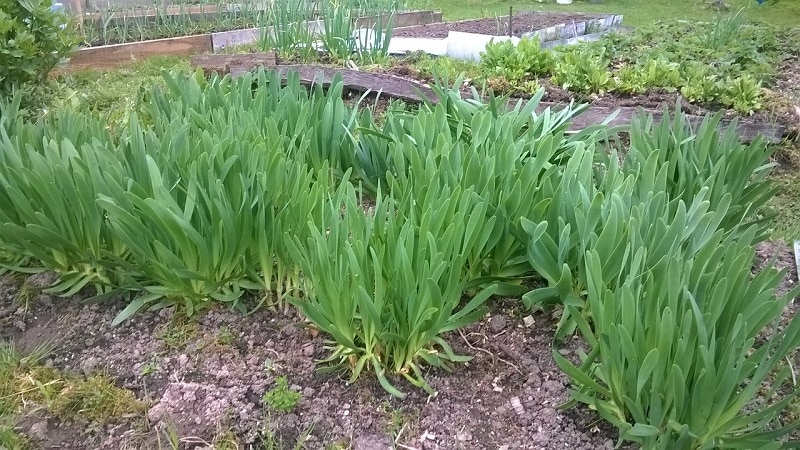
Preparing for landing
Before sowing, planting material is prepared:
- The seeds are placed in a weak solution of potassium permanganate for 10 seconds, after which they are washed in running water.
- They are then soaked in a growth stimulant, such as Epine. To do this, dilute 1 ml of the drug in 2 liters of water.
- After 8-10 hours, the seeds are removed from the solution and dried thoroughly.
Slime onions are planted for seedlings in early March.. A wooden box or plastic container is filled with nutrient soil and grooves 10 mm deep are made in it. They are watered generously with warm water and the seeds are placed in the recesses at a distance of 1 cm from each other.
The plantings are covered with a light substrate and sprayed with a spray bottle.. The container is covered with glass, a plastic bag or plastic film. The covering material is removed after the first shoots appear.
Soil requirements
Slime prefers fertile loamy soils and grows well in peat bogs. The area under the garden bed is carefully dug up, earth lumps are broken up and weed roots are removed. In the fall, it is recommended to dig up the soil with humus or manure, and in the spring add a little urea or special fertilizer for garlic to the planting holes.
The crop does not tolerate high soil acidity. This leads to coarsening of the foliage, depriving it of its juiciness, and also inhibits the growth and formation of slime.
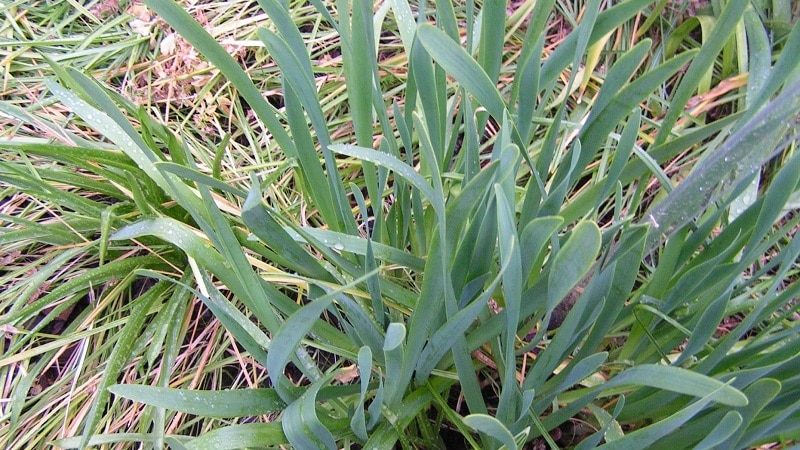
Dates, scheme and rules of planting
Planting in open ground is carried out after the snow has completely melted., and the soil will have time to dry out and warm up. In the northern regions this occurs in May, while in the southern regions sowing is often carried out at the end of April. This is done according to the following scheme:
- groove depth - 15 mm;
- distance between rows - 40 cm;
- between plants - 15-20 cm.
Culture is not afraid of winds and cold, so it can be planted in open, unprotected areas.But it is better to prepare a high bed so that the slime does not suffer from stagnant moisture and flooding.
Nuances of care
Such onions are grown as a perennial crop. Its foliage is cut off throughout the summer; this does not affect the abundance of the harvest and the formation of small bulbs. Between full harvests, a break of 2-3 weeks is taken, since new feathers grow in 15-20 days.
Without transplantation or propagation, onions actively grow for 4-5 years., and then begins to age: growth slows down, shoots die off. This variety goes into bloom late, towards the end of July.
Slime needs minimal care, its cultivation does not require investment of funds, as well as a big waste of time and effort.
Watering mode
Due to lack of moisture, onion feathers become stiff and lose their juiciness. During dry periods, the slime is watered generously every two days. In normal weather, you determine the watering schedule yourself, making sure that the soil in the garden bed always remains moist.
Attention! To reduce water evaporation and protect the crop from weeds, it is recommended to mulch the plantings with peat, hay or mowed grass.
Loosening the soil and weeding
After rains and watering, the bed is loosened to prevent the formation of a dense crust on the surface of the earth. Otherwise, it will prevent air from penetrating to the root system, and the bulbs will begin to rot. Weeds are removed as they arise.
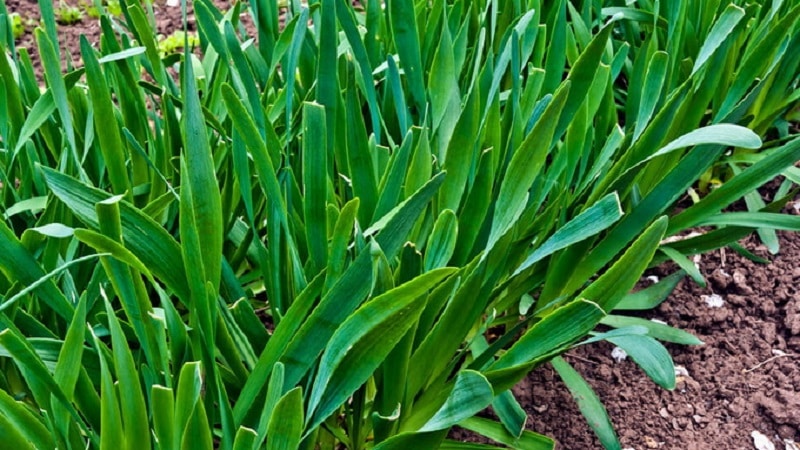
Top dressing
To get a rich harvest Experienced gardeners feed slime onions:
- In autumn, the bed is dug up with manure or compost (7-8 kg/m²).
- In spring, 5 g of urea is added to each plant.
- After cutting a large number of feathers, 1 m² of soil is fertilized with 30 g of superphosphate and 15 g of potassium salt.
Disease and pest control
Of the pests, the slime onion attracts only onion fly. To get rid of this insect, the bushes and soil in the garden bed are sprayed with a solution prepared according to the following recipe:
- laundry soap shavings - 50 g;
- wood ash - 100 g;
- water - 6 l.
Slime is resistant to many diseases, but it is affected by pathogenic microorganisms. In this case, the culture is watered with a solution of potassium permanganate. To do this, 10 g of potassium permanganate is diluted in 2 liters of warm water. This product is also used to treat cut areas of greenery.
Read also:
Harvest and storage
Knowing the peculiarities of collecting and storing slime onions will allow you to enjoy vitamin-rich greens for a long time.
How and when to collect
The harvest is harvested throughout the summer season. Feathers are cut off with a clean, sharp knife or scissors. The feathers are removed for the last time at the end of August, after which they stop watering the plant.
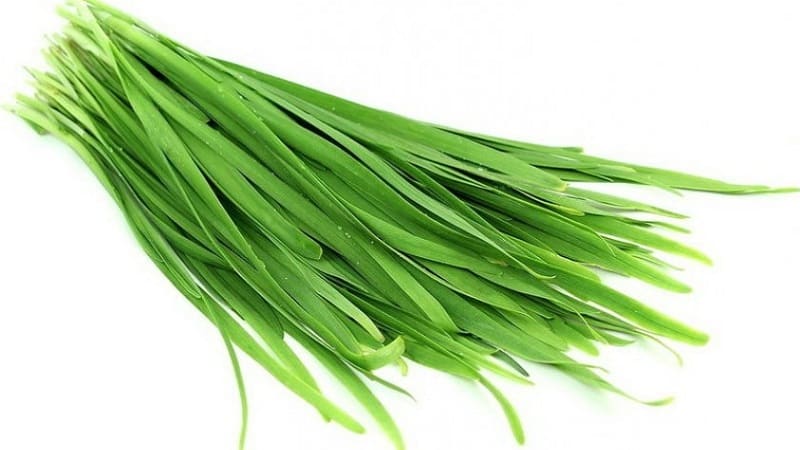
Storage features and keeping quality of the variety
Greens are packaged in plastic bags and placed in the refrigerator. Onions remain fresh and juicy for one week. The harvest is also chopped, distributed into containers and sent to the freezer. Frozen feathers will be edible throughout the winter.
Important! To compensate for the lack of amino acids and minerals, it is enough to eat 250-300 mg of slime feathers daily during the summer season.
Advice from experienced gardeners
Experienced summer residents, who have been growing slime on their plots for many years, share tips on caring for this crop. They note that important for obtaining succulent feathers:
- always keep the soil in the garden moist;
- do not forget about mulching;
- avoid excessive waterlogging;
- plant bushes on hills or raised raised beds;
- cut leaves 15-20 cm long.
Reviews of onion-slime
The slime bow already has a lot of positive reviews.
Ivan, Kazan: “I’ve been growing slime onions in my garden for about 10 years. Every 2-3 years I propagate it by dividing the bulbs or planting seeds. I really like that it has delicate greens without bitterness, which is not scary to give to children.”.
Anfisa, Azov: “Slime not only produces juicy and healthy greens, but also has good decorative qualities. It looks especially beautiful with lilac balls-inflorescences".
Conclusion
Slime onions have a good taste and many useful qualities. Eating vitamin-rich greens not only strengthens the immune system, but also eliminates the signs of vitamin deficiency. Its unpretentiousness and lack of special requirements for growing conditions make this crop in demand in summer cottages and vegetable gardens.